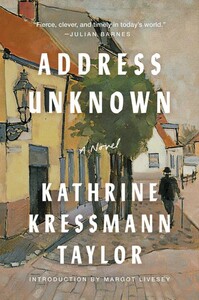You need to sign in or sign up before continuing.
Take a photo of a barcode or cover
challenging
dark
emotional
reflective
sad
fast-paced
Plot or Character Driven:
Plot
Strong character development:
Complicated
Loveable characters:
Complicated
Diverse cast of characters:
Yes
Flaws of characters a main focus:
Yes
Just finished this short American classic. I read it in one sitting and genuinely had my hand clasped over my mouth at multiple points. I was angry, sad, and so satisfied by the end. Do yourself a favor and spend an hour with this 5/5 star story!
Wow. Good, quick book and even more fascinating learning about the events leading to the author writing this story back in 1938.
Es un relato corto sobre el surgimiento del nazismo y la relación de amistad entre un norteamericano y un alemán y su evolución. Merece la pena leerlo.
Essential reading for everyone. Fantastic and precise.
Very moving, and - I am afraid - ever-relevant. An amazing, very quick read (only ca. 50 pages), with a shocking ending that will leave you reeling and re-reading the last few pages to make sure you understood correctly.
dark
emotional
informative
reflective
sad
tense
medium-paced
Graphic: Hate crime, Xenophobia
Moderate: Death
Poignant and eerily moving — with the plot a knife at the end — Taylor (whose own story as an author is interesting in and of itself) delivers a correspondence between two German business partners and friends. Max, a German Jew living in the United States, and Martin, a German gentile who returns with his family to Germany pulled by the promise of rebuilding the country following the Great War, write letters to each other over the course of sixteen months from 1932 to 1934.
"Who is this Adolf Hitler who seems rising towards power in Germany? I do not like what I read of him."
Taylor managed to build so much backstory and stress as the messages continue and the dates on the letters, and their contents, tick closer to a future we know is inevitable. But Taylor still surprises by the end. Astoundingly, this was first published in 1938 in Story magazine, and that knowledge, coupled with the dates of the letters, add an incredible amount of tension to this impactful novella.
Audiobook, as narrated by [a:George Newbern|3461329|George Newbern|https://s.gr-assets.com/assets/nophoto/user/u_50x66-632230dc9882b4352d753eedf9396530.png] and [a:Rob Shapiro|2887475|Rob Shapiro|https://s.gr-assets.com/assets/nophoto/user/u_50x66-632230dc9882b4352d753eedf9396530.png]: Wonderful performances from Newbern and Shapiro here as they deliver a back-and-forth correspondence. To be able to allow the deeply moving story from Taylor to rise up above a performance through the simple act of reading letters, attests to the skills these two men assuredly possess.
"Who is this Adolf Hitler who seems rising towards power in Germany? I do not like what I read of him."
Taylor managed to build so much backstory and stress as the messages continue and the dates on the letters, and their contents, tick closer to a future we know is inevitable. But Taylor still surprises by the end. Astoundingly, this was first published in 1938 in Story magazine, and that knowledge, coupled with the dates of the letters, add an incredible amount of tension to this impactful novella.
Audiobook, as narrated by [a:George Newbern|3461329|George Newbern|https://s.gr-assets.com/assets/nophoto/user/u_50x66-632230dc9882b4352d753eedf9396530.png] and [a:Rob Shapiro|2887475|Rob Shapiro|https://s.gr-assets.com/assets/nophoto/user/u_50x66-632230dc9882b4352d753eedf9396530.png]: Wonderful performances from Newbern and Shapiro here as they deliver a back-and-forth correspondence. To be able to allow the deeply moving story from Taylor to rise up above a performance through the simple act of reading letters, attests to the skills these two men assuredly possess.
A sensation when it first appeared in 1938, Taylor’s powerful story alerted a complacent, isolationist United States to the rising Nazi menace (alas, too late), all in the guise of a grimly satisfying thriller, easily digested over a lunch hour. Through a sequence of letters starting in 1932 between Max Eisenstein, a Jewish art dealer in San Francisco, and his business partner Martin Schulse, newly repatriated to his native Munich, we witness with alarming immediacy the insidious progress of fascist ideology. Reluctant at first (“Is he quite sane?”), Martin soon falls under the resistless, dehumanizing sway of Germany’s “Glorious Leader,” opening a perilous chasm between the friends. With masterful economy, Taylor (1903–96) uses the silences between letters to disturbing and ultimately devastating effect. At perhaps no time since its initial publication has this stunning evocation of extremism and intolerance felt more chilling. As the foreword to the 1938 edition suggested, this story deserves a permanent place on the country’s bookshelf.
A good book with substance doesn't need to be wordy. This short work by Kathrine Kresmann Taylor is a powerful read. Avoiding spoilers, all I can say is "Address Unknown" is disturbing in many subtle ways. Still relevant to us, ranging from macro to micro aspects in our daily lives, half a century after its publication. Definitely a VERY good read.




